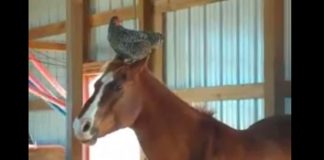
While days outside at the barn during the winter might seem impossible, they can actually be the most fun and rewarding because you know you’ve put in the effort while others may have just given up. Here are some tips to keep active, and warm, throughout the winter.
Stick With It
Dress For It
Getting dressed for your winter riding and barn chores requires a strategic approach. You’ll want to put some planning into your layers when going outside.
If your barn is unheated, you’ll definitely want to layer up. Use winter coveralls for maximum warmth while mucking out and doing other non-riding tasks.
Don’t let the lower temps scare you away from outdoor rides. The key to dressing for cold rides is to not end up soaked with sweat. If you’re warm when you step outside, you may be dressed too warmly to ride. You want to start out feeling cool, because you’ll warm up once you get moving. Also, do your warmup, stretching and cool down inside to reduce your exposure to the cold.
For English riders, wear winter tights or breeches made to keep you warm, such as those with a fleece lining. Western riders can get away with wearing layers (such as silk tights or compression tights) under jeans. Beware of coats that are too bulky, as they can hinder your ability to ride.
Don’t forget to protect your extremities. Try a thin fleece headband under your helmet to keep your ears warm and protected from the blustery air. Get some good winter riding gloves and socks to keep fingers and toes toasty.
If you’re going out on the trails, try to start your ride going into the wind, so you and your horse are working the hardest when you’re both fresh and not sweating.
Be Smart
When it comes to riding and chores, be smart. If you’re going to ride outside, take a little longer to warm up inside, and take the time to stretch and cool down properly afterward to avoid injury.
And don’t ignore the weather reports. Once temperatures drop below freezing, frostbite can be a factor on exposed skin in as little as 30 minutes, especially when wind chill levels dip below zero. If it’s raining, stay inside. Exercising in cold, rainy weather can increase your risk of hypothermia (dangerously low body temperature).
Dress to Beat Winter
If it’s dark when you’re riding outside, wear reflective clothing. During the day, be sure to wear sunscreen on your face and lip balm with SPF. Sunglasses can help protect your eyes from the glare coming off the snow on sunny days.
Layering for winter chores and riding is an art. A good rule of thumb is to dress like it’s 15 to 20 degrees warmer outside than it actually is; this way there is room for your body temperature to increase and stay comfortable in your clothing while outside.
Here’s how to layer:
Base Layer
This should be a snug, breathable shirt made of a synthetic fabric or silk that can wick sweat away from the skin. (Avoid cotton, as this fiber holds onto moisture and quickly loses warming power.)
Middle Layer
This should be a fleece or wool shirt that can provide insulation. Add breathable gloves and something to protect your ears.
Outer Layer
Look for wind- and water-resistant jackets to wear when the temperatures are below freezing. For temperatures near zero, add a fourth layer under the outer layer and a ski mask to protect your face.
Quick Winter Health Tips for Equestrians
Eat Well
Winter makes it tempting to load up on comfort food, which can pack on the weight.
Choose low-fat, healthy carbs to help avoid bingeing.
Drink Water
Don’t forget to stay hydrated; just because it’s cold outside doesn’t mean you can’t
become dehydrated easily.
Mini Workouts
If winter means more screen time and less barn time, take breaks or use commercials to get your blood flowing with some quick workout moves you can do in your pajama pants.
Light & Bright
Try to spend at least 20 minutes a day outside or near a bright window to amp up your serotonin, which affects your mood, appetite, digestion and sleep.
See more Fit Rider resources >>
MEGAN ARSZMAN is a freelance writer based in Indiana, where she’s learning to balance motherhood with horses, dogs and writing.
This article originally appeared in the December 2016 issue of Horse Illustrated magazine. Click here to subscribe!





